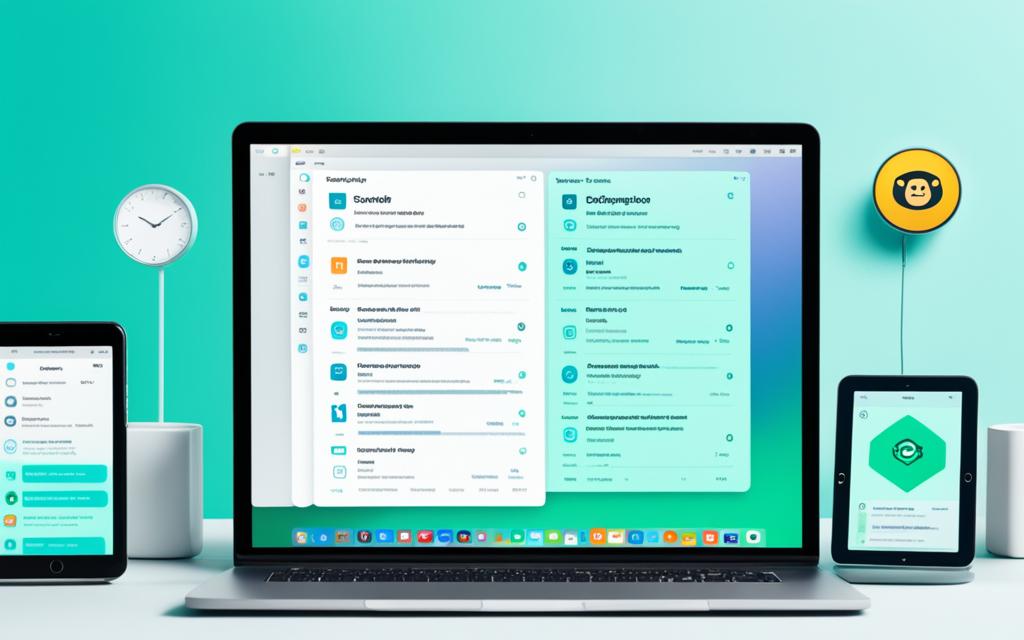If you’re running a business, you know how crucial email marketing is for reaching and engaging with your audience.
It’s a powerful tool that allows you to build relationships, drive conversions, and ultimately grow your business.
But with so many email marketing platforms out there, how do you choose the right one that suits your specific needs?
In this article, we’ll compare two popular options: GetResponse and Mailchimp.
Sending emails, creating landing pages, automating marketing, building conversion funnels, boosting sales, everything made easier with GetResponse.
GetResponse is a comprehensive email marketing and online campaign platform that provides a range of features to help businesses and individuals effectively manage their email marketing efforts.
Similarly, Mailchimp also offers email marketing and marketing automation features helping businesses of all sizes engage with their customers and grow their audience.
As we move forward, we will find out more about their key features, pricing plans, user interface, email marketing capabilities, customization options, and additional tools.
We believe that by the end, you’ll come to know if one of these platforms can help you achieve your business goals.
Let’s get started.
User Interface
GetResponse provides users with an intuitive and user-friendly interface that makes navigation a breeze.
From the moment you log in, you’ll find a clean and organized dashboard that gives you a clear overview of your campaigns, subscribers, and automation workflows.
The tools menu offers easy access to all the essential features, allowing you to create and manage your email campaigns with ease.
Similarly, Mailchimp also offers a user-friendly interface that is particularly suited for beginners.
With its sleek design and straightforward layout, you can quickly get started with creating your email campaigns.
The tools menu provides easy access to a wide range of features, including automation, templates, and integrations.
Overall, both GetResponse and Mailchimp offer user-friendly interfaces that are easy to navigate and use.
However, GetResponse’s dashboard and tools menu provide a more comprehensive and extensive set of features.
Email Marketing Capabilities
When it comes to email marketing, both GetResponse and Mailchimp offer a wide range of capabilities to help you create engaging and effective campaigns.
Let’s explore the features and options provided by these platforms.
Newsletters, Autoresponders, & RSS-to-Email
With GetResponse and Mailchimp, you can easily create and send newsletters to keep your subscribers informed about your latest updates, promotions, and news.
Additionally, both platforms offer autoresponder functionality, allowing you to set up automated email sequences that are triggered by specific actions or events.
If you have a blog or RSS feed, you can utilize RSS-to-email functionality to automatically send updates to your subscribers whenever you publish new content.
This can save you time and effort by eliminating the need to manually send emails with each new post.
Automation Messages & Transactional Emails
Both GetResponse and Mailchimp provide robust automation capabilities, enabling you to send automated messages based on specific triggers, such as user actions or segmentation criteria.
This allows you to nurture leads, onboard new subscribers, and provide tailored content based on individual preferences and behaviors.
Transactional emails play a vital role in providing timely and relevant information to your customers.
Both platforms offer the ability to send transactional emails, such as order confirmations, shipping notifications, and password resets, ensuring a seamless customer experience.
Sending emails, creating landing pages, automating marketing, building conversion funnels, boosting sales, everything made easier with GetResponse.
Email Templates & Builders
When it comes to email design, GetResponse offers around 150 email templates, giving you a wide range of options to choose from.
Their drag-and-drop email builder allows you to customize these templates and create visually appealing emails without any coding knowledge.
Mailchimp provides over 100 pre-built email templates, catering to various purposes such as promotional emails, e-commerce emails, and one-off emails.
Their drag-and-drop builder empowers you to effortlessly design eye-catching emails that resonate with your audience.
Both platforms also offer A/B testing capabilities, allowing you to test different email elements, such as subject lines, content variations, and call-to-action buttons.
This helps you optimize your campaigns by identifying the most effective strategies and improving your email engagement rates.
Whether you choose GetResponse or Mailchimp, you’ll have access to advanced email marketing features that let you create compelling campaigns and automate your workflows.
Customization & Personalization
When it comes to customization and personalization options, both GetResponse and Mailchimp have a lot to offer.
Let’s take a closer look at what each platform brings to the table.
Segmentation & Personalization
GetResponse shines in the area of advanced segmentation capabilities. With this feature, you can create highly targeted email campaigns and deliver personalized content to specific segments of your audience.
Mailchimp provides advanced personalization options such as merge tags and conditional content.
These features allow you to dynamically insert customer-specific information into your emails, creating a more personalized experience for your subscribers.
Automation Actions
With GetResponse, you can set up automation workflows with a wide range of actions and triggers.
This gives you the power to create personalized customer journeys based on user behavior. Mailchimp, while also offering automation capabilities, has more limited functionality in this area compared to GetResponse.
Sending emails, creating landing pages, automating marketing, building conversion funnels, boosting sales, everything made easier with GetResponse.
Custom Audiences
GetResponse allows you to create an unlimited number of custom audiences, giving you the freedom to segment your subscribers in any way you choose.
In contrast, Mailchimp allows only five email lists unless you opt for the Premium Plan.
This limitation may affect your ability to target and personalize your email campaigns effectively.
Also Read: Beehiiv vs ConvertKit vs Substack
Additional Tools & Integrations
GetResponse provides a comprehensive set of tools, including features like landing pages, webinars, web push notifications, conversion funnels, and postcards.
The tools allow you to create impactful landing pages, host webinars, send web push notifications to engage with your audience, track and optimize your conversion funnels, and even send physical postcards to your subscribers.
Similar to GetResponse, Mailchimp offers a variety of additional tools to enhance your email marketing campaigns.
With Mailchimp, you can create landing pages, host websites, and utilize their extensive library of automation templates.
These templates cover a wide range of automation scenarios and are designed to help you engage with your audience more effectively.
Integrations are another crucial aspect to consider when choosing an email marketing platform.
Mailchimp takes the lead in this category, working with a larger number of apps and platforms compared to GetResponse.
Mailchimp integrates seamlessly with popular platforms like WordPress and Facebook, allowing you to connect your email marketing efforts with your existing systems and expand your reach.
Sending emails, creating landing pages, automating marketing, building conversion funnels, boosting sales, everything made easier with GetResponse.
GetResponse also offers a considerable number of integrations, with support for platforms like Shopify and Instapage.
These integrations enable you to synchronize your email marketing campaigns with your ecommerce store or landing pages, providing a seamless user experience for your customers.
While GetResponse excels in providing unique features like webinars, web push notifications, and conversion funnels, Mailchimp stands out with its wide range of app integrations, allowing you to connect with various platforms and services.
Support & Customer Service
Availability
GetResponse and Mailchimp provide customer support through email and chat.
However, GetResponse goes the extra mile by offering support via phone as well, ensuring that users have multiple channels to resolve their queries and receive timely assistance.
Check Out: Beehiiv vs Brevo
24/7 Customer Support
While both platforms prioritize customer support, GetResponse stands out with its 24/7 customer support.
This ensures that users can get help whenever they need it, even outside of regular business hours.
Mailchimp offers support during business hours, which may be limiting for users in different time zones or those who require immediate assistance.
Resources & Knowledge Base
Both GetResponse and Mailchimp provide resources such as knowledge bases, tutorials, and guides to help users navigate their platforms effectively.
These resources can be valuable for beginners and users looking to explore more advanced features.
Explore: Systeme vs Mailchimp
Pricing
Let’s compare the pricing plans of GetResponse and Mailchimp to help you determine which one suits your budget and needs.
Mailchimp offers four plans: Free, Essentials, Standard, and Premium. The pricing starts at $13 per month for up to 500 subscribers and goes up to $350 per month for up to 10,000 subscribers.
The Free plan includes one audience, basic templates, 1-click email automation, and basic CRM features.
Sending emails, creating landing pages, automating marketing, building conversion funnels, boosting sales, everything made easier with GetResponse.
GetResponse pricing has something for all.
- The Free plan allows upto 2500 sends every month.
- There is an Email Marketing plan priced at $13.2/m, billed annually.
- The Marketing Automation plan costs $41.1/m, billed annually.
- The Ecommerce Marketing plan which costs $82.9/m.
- The Get Response Max plan is for businesses having a large number of subscribers.
- Besides the 30-day free trial, GetResponse gives you the flexibility to pay every month, annually, and once every two years.
- Check out the pricing page here for features each plan offers.
All in all, GetResponse’s pricing structure, combined with its extensive feature set and transparent approach, makes it an attractive choice for businesses looking to get the most value out of their email marketing investment.
However, it’s essential to assess your specific requirements and compare them with the pricing and features of both platforms to make an informed decision.
Conclusion
With what we have learnt just now, GetResponse appears to offer more value and a wider range of features at a lower cost.
With its intuitive user interface, extensive customization options, and superior deliverability rate, GetResponse stands out as a powerful email marketing platform.
While Mailchimp excels in reporting software, non-marketing features, and template editor, it comes with a higher cost and limited template designs.
In short, GetResponse has an edge over Mailchimp.













